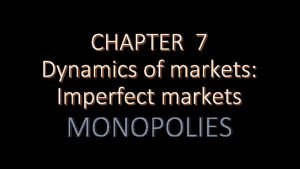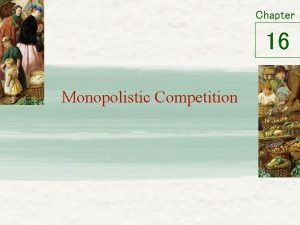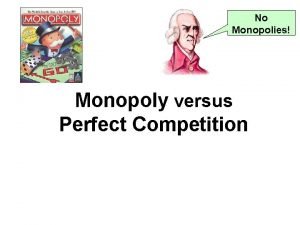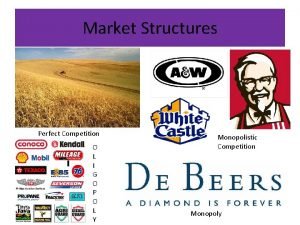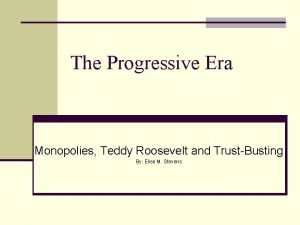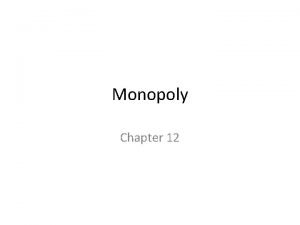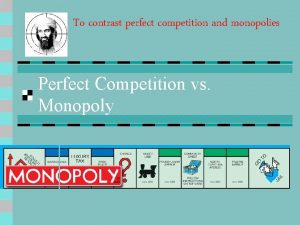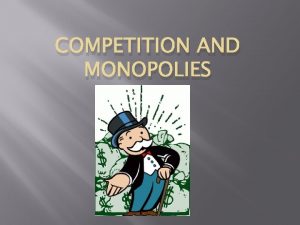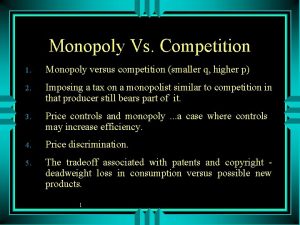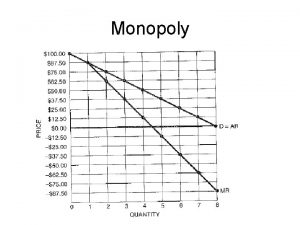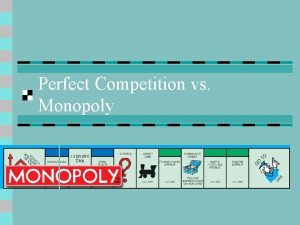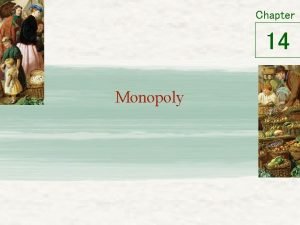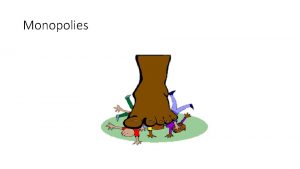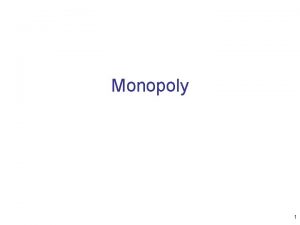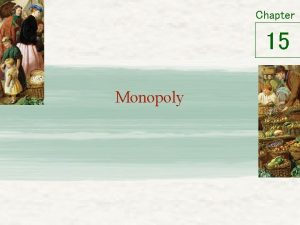No Monopolies Monopoly versus Perfect Competition Demand Curves
















- Slides: 16

No Monopolies! Monopoly versus Perfect Competition

Demand Curves Competitive vs. Monopoly (a) (b) Competitive Firm’s Demand Curve Price ’ Demand Curve Monopolist’s Price MC MC D = MR $15 D ≠ MR 0 Quantity of Output A Monopoly is the sole producer => therefore it faces the entire market demand curve

Marginal Revenue Handout

Demand & Marginal-Revenue Price $11 10 9 8 7 6 5 4 3 2 1 0 – 1 – 2 – 3 – 4 If a monopoly wants to sell more, it must lower price. Price falls for ALL units sold. This is why MR is < P. Price = AR Demand Marginal revenue 1 2 3 4 (average revenue) 5 6 7 8 Quantity of Water

Profit Maximization • All profit-maximizing firms set: MR =MC • Competitive firms: P = MR = MC • Monopoly firm = P > MR = MC

Monopoly vs. Perfect Competition • Monopolies charge a higher price & provide lower Qty • Monopoly charges a Price > MC – Competitive firms: Price = MC • Monopolies create deadweight loss to society – Competitive firms: no deadweight loss

Monopolist Equilibrium Costs and Revenue Profit = (P – ATC) * Qty MC ($20 - $10) * 100 = $1, 000 profit E 1 $20 P 1 Monopoly Profit ATC Set MR = MC $10 ATC D MR 0 Q 1 100 Quantity

Sample Monopoly Equilibrium Costs and Revenue Maximize Profit set MR = MC MC Profit = (P – ATC) * Qty E 1 P 1 Monopoly profit ATC Maximize Total Revenue: Set MR = 0 ATC D MR 0 Q 1 Quantity

Pure Monopoly Worksheet

Pure Monopoly Problem #1 Costs and Revenue Profit = $150 per unit (P – ATC) * Qty MC ($750 - $600) * 4 = $600 profit E 1 $750 P 1 Monopoly profit ATC Produce 4 Units MC = MR @ $300 $600 ATC D MR 0 Q 1 4 Quantity

Worksheet Problem #2 Costs and Revenue Profit = (P – ATC) * Qty MC $15 P 1 ($15 - $8) * 100 = $700 profit E 1 Monopoly profit $8 ATC D MR 0 Q 1 100 Quantity

Quick Review: PC vs. Monopoly

Collusion & Cartels • Collusion – An agreement among firms about Qty to produce or price to charge – Antitrust laws prohibit this behavior in USA • Cartel – A group of firms acting in unison – Example: OPEC Meeting

How to become a price setter

De. Beers Video

Graphing Supply & Demand S 2 ----- P 1 -------- E 1 D 1 -------------- S 1 P 2 --------- E 2 S 1 P 1 -------- E 1 Q 1 D 2 Q 1 Q 2 • Demand is kept artificially high & inelastic through advertising • Supply is kept artificially low by De. Beers • End Result: Higher prices paid & larger quantity sold
 Dynamics of imperfect market
Dynamics of imperfect market Lump sum subsidy
Lump sum subsidy Difference between perfect competition and monopoly
Difference between perfect competition and monopoly P=mc
P=mc Example of pure competition
Example of pure competition Difference between perfect competition and monopoly
Difference between perfect competition and monopoly Monopoly vs monopolistic competition
Monopoly vs monopolistic competition Competition refers to
Competition refers to Trust busting progressive era
Trust busting progressive era Monopolistic competition pictures
Monopolistic competition pictures Difference between monopoly and monopolistic competition
Difference between monopoly and monopolistic competition Pure competition and monopoly _____
Pure competition and monopoly _____ Marshallian hicksian slutsky demand curves
Marshallian hicksian slutsky demand curves Market structure venn diagram
Market structure venn diagram Monopoly demand curve
Monopoly demand curve Present perfect
Present perfect Theory of monopoly
Theory of monopoly
